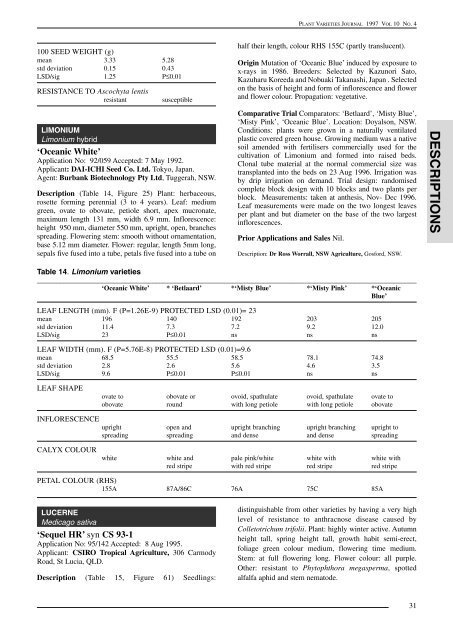62. Volume 10- Number 4 - IP Australia
62. Volume 10- Number 4 - IP Australia
62. Volume 10- Number 4 - IP Australia
You also want an ePaper? Increase the reach of your titles
YUMPU automatically turns print PDFs into web optimized ePapers that Google loves.
DESCR<strong>IP</strong>TIONS<br />
PLANT VARIETIES JOURNAL 1997 VOL <strong>10</strong> NO. 4<br />
<strong>10</strong>0 SEED WEIGHT (g)<br />
mean 3.33 5.28<br />
std deviation 0.15 0.43<br />
LSD/sig 1.25 P≤0.01<br />
RESISTANCE TO Ascochyta lentis<br />
resistant<br />
susceptible<br />
LIMONIUM<br />
Limonium hybrid<br />
‘Oceanic White’<br />
Application No: 92/059 Accepted: 7 May 1992.<br />
Applicant: DAI-ICHI Seed Co. Ltd. Tokyo, Japan.<br />
Agent: Burbank Biotechnology Pty Ltd, Tuggerah, NSW.<br />
Description (Table 14, Figure 25) Plant: herbaceous,<br />
rosette forming perennial (3 to 4 years). Leaf: medium<br />
green, ovate to obovate, petiole short, apex mucronate,<br />
maximum length 131 mm, width 6.9 mm. Inflorescence:<br />
height 950 mm, diameter 550 mm, upright, open, branches<br />
spreading. Flowering stem: smooth without ornamentation,<br />
base 5.12 mm diameter. Flower: regular, length 5mm long,<br />
sepals five fused into a tube, petals five fused into a tube on<br />
half their length, colour RHS 155C (partly translucent).<br />
Origin Mutation of ‘Oceanic Blue’ induced by exposure to<br />
x-rays in 1986. Breeders: Selected by Kazunori Sato,<br />
Kazuharu Koreeda and Nobuaki Takanashi, Japan . Selected<br />
on the basis of height and form of inflorescence and flower<br />
and flower colour. Propagation: vegetative.<br />
Comparative Trial Comparators: ‘Betlaard’, ‘Misty Blue’,<br />
‘Misty Pink’, ‘Oceanic Blue’. Location: Doyalson, NSW.<br />
Conditions: plants were grown in a naturally ventilated<br />
plastic covered green house. Growing medium was a native<br />
soil amended with fertilisers commercially used for the<br />
cultivation of Limonium and formed into raised beds.<br />
Clonal tube material at the normal commercial size was<br />
transplanted into the beds on 23 Aug 1996. Irrigation was<br />
by drip irrigation on demand. Trial design: randomised<br />
complete block design with <strong>10</strong> blocks and two plants per<br />
block. Measurements: taken at anthesis, Nov- Dec 1996.<br />
Leaf measurements were made on the two longest leaves<br />
per plant and but diameter on the base of the two largest<br />
inflorescences.<br />
Prior Applications and Sales Nil.<br />
Description: Dr Ross Worrall, NSW Agriculture, Gosford, NSW.<br />
Table 14. Limonium varieties<br />
___________________________________________________________________________________________________<br />
‘Oceanic White’ * ‘Betlaard’ *‘Misty Blue’ *‘Misty Pink’ *‘Oceanic<br />
Blue’<br />
LEAF LENGTH (mm). F (P=1.26E-9) PROTECTED LSD (0.01)= 23<br />
mean 196 140 192 203 205<br />
std deviation 11.4 7.3 7.2 9.2 12.0<br />
LSD/sig 23 P≤0.01 ns ns ns<br />
LEAF WIDTH (mm). F (P=5.76E-8) PROTECTED LSD (0.01)=9.6<br />
mean 68.5 55.5 58.5 78.1 74.8<br />
std deviation 2.8 2.6 5.6 4.6 3.5<br />
LSD/sig 9.6 P≤0.01 P≤0.01 ns ns<br />
LEAF SHAPE<br />
ovate to obovate or ovoid, spathulate ovoid, spathulate ovate to<br />
obovate round with long petiole with long petiole obovate<br />
INFLORESCENCE<br />
upright open and upright branching upright branching upright to<br />
spreading spreading and dense and dense spreading<br />
CALYX COLOUR<br />
white white and pale pink/white white with white with<br />
red stripe with red stripe red stripe red stripe<br />
PETAL COLOUR (RHS)<br />
155A 87A/86C 76A 75C 85A<br />
LUCERNE<br />
Medicago sativa<br />
‘Sequel HR’ syn CS 93-1<br />
Application No: 95/142 Accepted: 8 Aug 1995.<br />
Applicant: CSIRO Tropical Agriculture, 306 Carmody<br />
Road, St Lucia, QLD.<br />
Description (Table 15, Figure 61) Seedlings:<br />
distinguishable from other varieties by having a very high<br />
level of resistance to anthracnose disease caused by<br />
Colletotrichum trifolii. Plant: highly winter active. Autumn<br />
height tall, spring height tall, growth habit semi-erect,<br />
foliage green colour medium, flowering time medium.<br />
Stem: at full flowering long. Flower colour: all purple.<br />
Other: resistant to Phytophthora megasperma, spotted<br />
alfalfa aphid and stem nematode.<br />
31

















